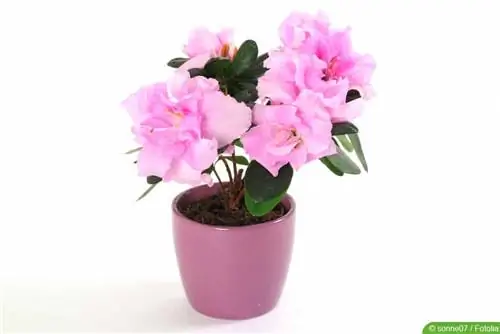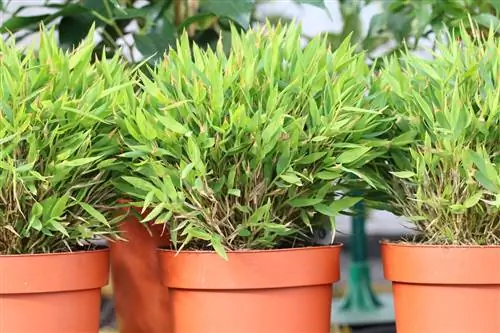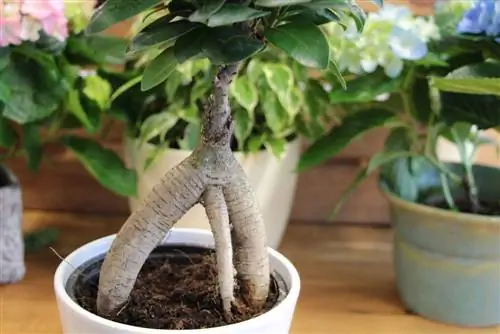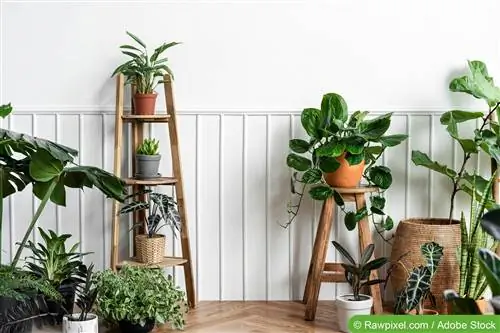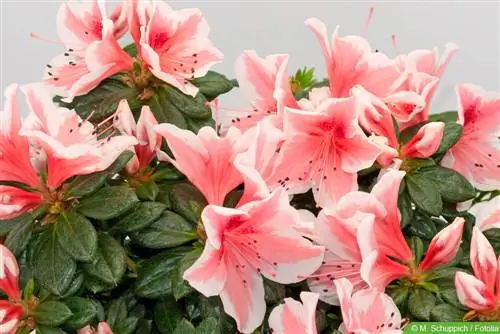- Author admin [email protected].
- Public 2023-12-17 03:39.
- Last modified 2025-06-01 06:48.
Icy winters and flowering branches. A rare combination. The indoor azalea comforts us through the dreary season. The green leaves almost completely disappear under the weight of the colorful flowers. White, pink or red specimens can inhabit our home individually or together. Who this azalea, offered. Rhododendron simsii, who wants to immediately give a cozy and warm welcome, is wrong. Cool air is their elixir of life.
Indoor location
The original plant Rhododendron simsii comes from the damp, cold forests of Japan and China. However, during its main flowering period from September to April, it is too cold outdoors in this country. However, the conditions in warm living rooms are not exactly ideal. Although the cultivated varieties tolerate higher temperatures.
- A cool hallway is ideal
- also a slightly heated bedroom
- and other bright, cool rooms
- Temperature values between 8-16 °C are optimal
- The azalea can be kept temporarily warmer during the flowering period
- do not place close to a heater
- also avoid window sills above the heating
- Drafts and direct sunlight are not good for you
- It is better to choose a shady to semi-shady location
- Morning and evening sun are welcome
Outdoor location
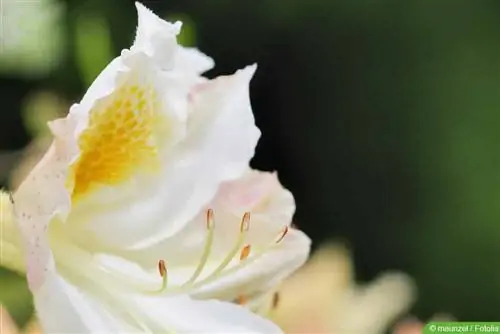
In their homeland, azaleas are outdoor plants. If possible, this existence should also be made possible for them in this country in phases. From the end of May you can move outside. The place must be shady and protected. Staying outdoors promotes the flowering of the azalea and thus ensures the next round of flowers in the coming winter. You can place the pot on the balcony or terrace, or plant the azalea in garden soil. As soon as the first night frost appears, the azalea must return indoors. Also those specimens that were planted out.
Substrate
This winter bloomer is a houseplant with special substrate requirements. You should fulfill these for her own pleasure. It will stay he althy and bloom profusely if it is rooted as follows:
- in an acidic soil
- with pH value of 4 to 4.5
- humic but lime-free
- z. B. in rhododendron soil
- alternatively in high-quality potting soil with sand content
- enriched with acidic coniferous compost
Repotting
The substrate serves the indoor azalea for about two or three years, then it has to be replaced with a new one. With good care, the visible volume of the houseplant increases over time and needs a larger pot to compensate. Only then can the root growth keep up.
- repot every 2-3 years
- best time is after flowering
- before the azalea comes outdoors
- choose a larger planter
- shake old substrate from the fine roots
- remove dead roots
- cut back he althy roots a little
Pouring
When caring for this Asian immigrant, both the quality and quantity of water are important to her well-being.
- the warmer the room, the higher the water requirement
- the water supply must be uniform
- the root ball should always be moist
- but don't stand in waterlogged areas
- if applicable Put a few stones in the bottom of the planter
- the water must not be very calcareous
- otherwise the flowering period will be short or not at all
- chlorosis (yellowing of the leaves) can also occur
- Rainwater is ideal
- Soften the tap water beforehand and warm it to room temperature
- uniformly high humidity is also a must
- spray lukewarm daily
- but only the leaves, not the flowers!
Fertilize
Here, too, the azalea turns the gardener's usual care upside down. Other plants are fertilized during the flowering period, but the azalea is not.
- fertilize outside the flowering phase
- from spring to the beginning of autumn
- Use liquid fertilizer once a month
- best to use the special azalea and rhododendron fertilizer
- pause fertilizing from autumn onwards
Cutting
Cutting is part of the necessary care for this houseplant. However, this is done until it has completely faded. Withered parts of the azalea are excluded from this. You must cut these as soon as possible or remove them by hand so that they do not start to rot in humid air. This cleaning action also ensures a more beautiful appearance. As soon as the last flower has faded, shape-preserving pruning awaits. How to cut the indoor azalea correctly:
- use very sharp scissors
- the shoots must under no circumstances be crushed
- Scissors must also be clean and disinfected
- Cut back houseplant to 1/3
- cut above an eye or leaf or side bud
- cut away dead branches completely
Tip:
Don't forego this pruning measure, as it promotes an attractive bushy shape.
Propagate
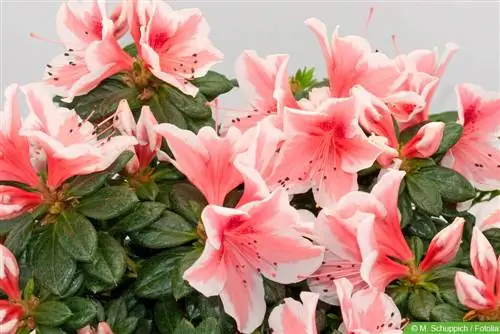
Invest in an azalea once and still transform the entire home into a winter sea of flowers. This can be achieved through reproduction. All that is required is a little patience. And of course you have to make do with the fact that every plant blooms in the same way. These are the required steps:
- Take half-woody cuttings from the mother plant in early spring. These should each be 8 to 10 cm long.
- Fill small pots with a mixture of sand and peat in a 2:1 ratio.
- Insert one cutting per pot into the soil, each 4 to 5 cm deep. You may need to remove the lower leaves first.
- Moisten the soil well. From now on, keep the soil consistently moist but not too wet.
- Put a clear plastic bag over each pot. This increases the humidity.
- Place the pots in partial shade.
- After about 8 to 12 weeks, the cutting has formed new roots and begins to grow. Now it's time to transplant it. An acidic substrate suitable for azaleas must be used.
Diseases and pests
It is usually a substrate that is too dry or too wet that kills this houseplant or at least weakens its he alth. Pests are happy about the latter, as they can conquer them in no time. The following species have been spotted on it:
- Thunderflies and their larvae
- Spider mites
- Aphids
- Whiteflies
- during outdoor stay: black weevil
Thunderflies can be controlled with neem oil-based preparations. Collect the black weevil beetles and fight the larvae with nematodes. Aphids can be easily combated with various home remedies. For example, by spraying with a soft soap solution. To do this, 20 ml of soap is dissolved in 1 liter of water. The use of predatory mites, among other things, is helpful against spider mites, which love dry and warm locations. These in turn can be ordered easily and cheaply over the Internet. Yellow leaves can be a reaction to watering that is too hard. Experts speak of chlorosis.
Tip:
Repot a houseplant that is too wet in new substrate. Cut away any rotting roots.
Wintering
Overwintering an indoor azalea is a challenge. After all, we don't want to deprive ourselves of their beautiful flowers. Other plants are allowed to disappear into a densely packed winter quarters. But not the azalea! At its peak it needs the stage. Since her admirers live in warm rooms, it stands to reason that Azalea also spends the winter there. Nevertheless, try to overwinter them as follows if possible so that you can enjoy their flowers for a long time:
- wintering in the house
- at a temperature between 8 and 16 degrees Celsius
- more heat shortens the flowering period
- Place the plant in very bright light
- but away from heaters because the air there is too dry
- be sure to avoid waterlogging
Tip:
Clever azalea lovers move their azaleas daily. In the morning she comes to a place where she can be admired during the day. In the evening it is put back in a cool place. The azalea doesn't seem to mind these frequent moves.
Buying Tips
Don't let the numerous bright flowers seduce you into buying. These are rapidly approaching wilting. It makes much more sense to choose a specimen that will only come into full bloom at home. Closed buds can and should be present in abundance. But take a closer look at these:
- they should be plump and equally developed
- make sure the buds are dense
- even distribution is important
- some opened buds are ok
Does the azalea make a good impression overall? The pots often sit inconveniently in the market for days and do not receive the necessary care.
Other purchasing criteria
- the soil in the pot should be moist
- fallen buds are not a good sign
- the pot should be big enough
- at least half of the crown circumference
- the leaves should be shiny green and free of dirt
- there must be no traces of pests
Tip:
Even if you have already found the ideal location for the blooming azalea, only move in gradually after purchase. First keep it cool and shady for a few days, then it can get warmer.
Flower Variations
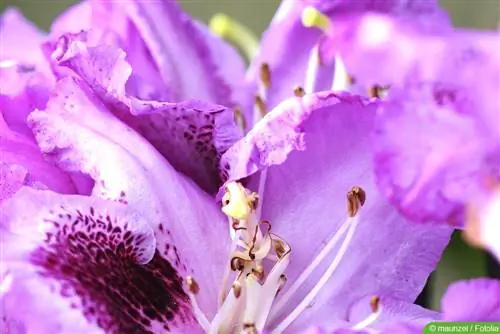
White and red - these are the two skin colors from which the indoor azalea draws as desired. Although the other color components are ignored, their flowers are by no means monotonous. Starting from white to the darkest red, every color nuance is covered. Occasionally fine patterns are added. Simple and double flowers, subtle differences in flower shape and variations in flowering time round off the variety. We have the hard-working breeders to thank for this. They have declared Rhododendron simsii one of their favorites. Take your time searching so that you can discover your absolute favorite among this we alth of offerings. Here are a few suggestions that can enchant you:
Alexander
- red
- simple flower
- Flowering period: January to May
Angelina
- pure white
- double flower
- Flowering period: February to May
Antarctica
- light purple
- simple flower
- Flowering period: February to May
Watercolor
- whitepink
- simple flower with very attractive markings
- Flowering period: August to May
Christine Matton
- salmon
- simple flower
- Flowering period: December to May
Lady Melanie
- soft pink
- white flower border
- dark speckles
- Flowering time: March to May
De Waele’s Favorite
- pink
- simple flower
- white flower border
- Flowering time: March to May
Friedhelm Scherrer Rose
- pink
- simple flower
- Color varies from light to dark
- Flowering period: January to May
Ilona
- pink
- simple flower
- wide flower border in white
- Flowering period: August to May
Inga
- pink
- simple flower
- white flower border
- Flowering period: August to May
Queen Fabiola
- white and orange-red
- simple and very beautiful flower
- Flowering period: February to May
Madame De Croock
- white flower
- lightly filled
- with red speckles in the middle
- Flowering period: November to February
Sachsenstern
- white
- simple flower
- delicate red flower edge
- Flowering period: February to May
Terra Nova
- pink
- funnel-shaped
- double flower
- Flowering time: August to April
Venus
- pink
- white flower border

